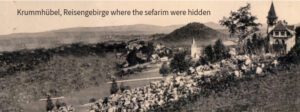Magnificent manuscript!
Kabbalistic Commentary on the Haggadah
The First Kabbalistic Commentary on the Haggadah
Kabbalistic commentary on the Pesach Haggadah by the great Kabbalist Rabbi Yosef Gikatilla, author of Shaarei Orah.
Rare Ashkenazic manuscript, written in clear, beautiful calligraphy, with dark red initials at the beginning of each paragraph.
Completed on the 4th of Nissan Prague, 1585.
The city of Prague, although a prime Jewish center, was continually devastated by fires and expulsions over the years. As a result, only a few complete manuscripts have survived intact, and very few are in as good condition as this manuscript.
Prague, 1585. [20] leaves (p. 18 is blank). Page size: 18×15 cm. owners signature in margins of leaf 9a. Minor tear with missing text on last line of leaf [15]. Water stains.
Beautiful new leather binding.
This commentary was first brought to print in Venice, 1602, 17 years after the manuscript was written. It is the first Kabbalistic Haggadah to be printed.
There are many textual variations between this manuscript and the Venetian edition.
Long and detailed colophon at end of the manuscript
I will praise my Creator, for having granted and merited me, for salvation and relief has come to me
I have found the commentary of Yetzias Mitzrayim
That the gaon Rabbi Yosef Gikatilla has composed…
I completed it on Wednesday the 4th of Nissan, 5345 (1585) ….here in Prague in the home of my father-in-law the captain, known to all as Mendel’n Chazzan.
May Hashem Yisbarach help me to write and prepare an endless amount of sefarim. May the pasuk “and the knowledge of Hashem will fill the world, as water covers the ocean” be fulfilled…
The book Mishpachos Prague (Prague Families) (Pressburg, 1892, p. 396) lists Menachem Bar Shmuel known as “Mendel Chazzan the elderly
shaliach tzibbur of old age, 1602.” Assumingly it is the same Rabbi Mendel Chazzan mentioned in the colophon.
Rabbi Yosef Gikatilla was one of the great kabbalists in the era of the Rishonim. He lived in 13th century Spain. He authored fundamental works of Kabbalah including Sharei Tzedek and Sharei Orah, which were among the first Kabbalistic works to be written after the discovery of the Zohar.
From Prague to Hamburg to America
The Fascinating Journey
The Story of the Miraculous Rescue of the Sacred Manuscript
The journey began in Prague, 1585
during the lifetime of the Maharal of Prague.
438 years ago…
This precious manuscript was handwritten in Prague in the year 1585, in an era when the city was replete with illustrious sages and tzaddikim, most notably among them the Maharal of Prague, Rabbi Yehuda Loew. The manuscript, a kabbalistic commentary on the Haggadah, authored by Rabbi Josef Gikatilla 13th Century, Spain, is the very first known kabbalistic commentary of its kind.
For many years, the manuscript was in the famous library of Rabbi Amram Hisch (1833-1909), Av Beis Din of Hamburg. After his passing, his widow sold a significant portion of his library, including this manuscript, to Rabbi Yosef Tzvi Carlebach (1883-1942), the last Chief Rabbi of Hamburg prior to the Holocaust.
Rabbi Yosef Tzvi Carlebach was known and respected by all German Jewry and devoted his life to helping others. After Nazi Germany banned Jewish students from attending German schools together with Aryan German children, Rabbi Carlebach set up a number of schools throughout Germany to educate Jewish children. His schools bore his name and were known as Carlebach-Schulen.
As the Nazi persecution increased, evil decrees grew more alarming each day, Rabbi Carlebach feared for the fate of his precious library. He searched a hiding place where he could conceal his library. He hid the books and manuscripts in Krummhübel a small town in the Slisein Giant Mountains (Reisengebirge).
With the outbreak of World War Two, Rabbi Carlebach was offered the opportunity to flee Hamburg, yet he valiantly chose to remain behind with his congregation alongside his wife and 4 young children.
In 1941, he published an article in Jewish newspapers expressing his objection to the war. His essay reached the office of the local S.S. commander who sent an order to Berlin to punish the author severely.
Due to his venerated status, the Nazis didn’t arrest him in his hometown of Hamburg, yet deceitfully sent him, his wife, and 4 little children, along with several thousand Jews, on a long journey that ended in Riga, Latvia.

He was murdered together with his wife and his 3 little children on March 26, 1942, during the mass shooting of approximately 1600 Jews, mostly older people and children. This went down in history as the Dünamünde Actio. Hashem yikom damam.
Of his younger children, the only one to survive was his son
Rabbi Shlomo Carlebach (1926-2022).
The Young Shlomo Carlebach was able to survive the Holocaust while suffering four years of internment in nine different concentration camps. Eventually, he made his way to the United States where he served as a mashgiach ruchani in Yeshivas Rabbeinu Chaim Berlin. After the war, Rabbi Shlomo went back to Germany in search of his father’s Library, hoping to retrieve his father’s precious sefarim. He was delighted to discover the entire library intact still hidden in the small town Krummhübel. He returned to the United States with the books and manuscripts. They remained in his possession until his passing last year in 2022 יהי זכרו ברוך.
The present item is an original manuscript from the library of Rabbi Yosef Tzvi Carlebach and subsequently his son, Rabbi Shlomo Carlebach z”l.
Sources: the family of the late Rabbi Shlomo Carlebach. Wikipedia
……………………………………….. .
Any inquiries about this lot ?